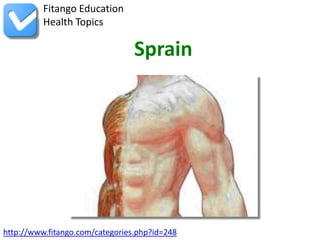
Sprain
- 1. Fitango Education Health Topics Sprain http://www.fitango.com/categories.php?id=248
- 2. Overview A sprain is an injury to a ligament (tissue that connects two or more bones at a joint). In a sprain, one or more ligaments is stretched or torn. 1
- 3. Symptoms The usual signs and symptoms of a sprain are: -- Pain -- Swelling -- Bruising Not being able to move or use the joint. 2
- 4. Symptoms Sometimes people feel a pop or tear when the injury happens. A sprain can be mild, moderate, or severe. 3
- 5. Causes Many things can cause a sprain. Falling, twisting, or getting hit can force a joint out of its normal position. This can cause ligaments around the joint to stretch or tear. Sprains can occur if people: 4
- 6. Causes -- Fall and land on an arm -- Fall on the side of their foot -- Twist a knee. 5
- 7. Treatment Treatments for sprains and strains are the same. To reduce swelling and pain in the first day or two, doctors usually say to: -- Rest the injured area. If the ankle or knee 6
- 8. Treatment is hurt, the doctor might tell you to use crutches or a cane. -- Put ice on the injury for 20 minutes at a time. The doctor might say to do this 4 to 8 times a day. -- Compress (squeeze) the injury using special 7
- 9. Treatment bandages, casts, boots, or splints. Your doctor will tell you which one is best for you and how tight it should be. -- Put the injured ankle, knee, elbow, or wrist up on a pillow. 8
- 10. Treatment -- The doctor may recommend taking medicines, such as aspirin or ibuprofen. After treating pain and swelling, doctors usually say to exercise the injured area. This helps to prevent stiffness and 9
- 11. Treatment increase strength. Some people need physical therapy. You may need to exercise the injured area or go to physical therapy for several weeks. Your doctor or physical therapist will tell you when you can start to do normal activities, 10
- 12. Treatment including sports. If you begin too soon, you can injure the area again. It is important to see a doctor if you have a painful sprain or strain. This helps you get the right treatments. 11
- 13. Prevention Can Sprains and Strains Be Prevented? To help prevent sprains and strains, you can: -- Avoid exercising or playing sports when 12
- 14. Prevention tired or in pain. -- Eat a well-balanced diet to keep muscles strong. -- Maintain a healthy weight. -- Try to avoid falling (for example, put sand 13
- 15. Prevention or salt on icy spots on your front steps or sidewalks). -- Wear shoes that fit well. -- Get new shoes if the heel wears down on one side. -- Exercise every day. 14
- 16. Prevention -- Be in proper physical condition to play a sport. -- Warm up and stretch before playing a sport. -- Wear protective equipment when playing. -- Run on flat surfaces. 15